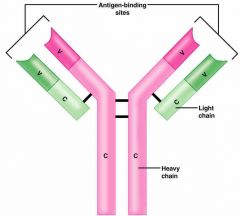![]()
![]()
![]()
Use LEFT and RIGHT arrow keys to navigate between flashcards;
Use UP and DOWN arrow keys to flip the card;
H to show hint;
A reads text to speech;
30 Cards in this Set
- Front
- Back
|
Memory cells |
• remain until infected by same antigen again (circulate in blood)way • if a person comes in contact with same antigen • memory cells rapidly divide (mitosis) into plasma cells and more memory cells • plasma cells repaid my produce antibodies that destroy pathogens • before symptoms can show |
|
|
Ways in which pathogens cause disease and may lead to death |
• Produce (release) toxins • Damage host cells -Can reproduce in cells -break down nutrients inside cell -rapture releasing nutrients |
|
|
Monoclonal antibodies |
Produced from a single clone of B-cells |
|
|
Antigen |
Protein/substance that triggers and immune response |
|
|
Why can't antigens lass through cell-surface membrane |
• too large to diffuse • not lipid soluble • don't have complementary shape to receptors |
|
|
Vaccines don't protect against other viruses |
• other viruses have different antigens • antibodies produced by memory cells won't be complementary to antigen |
|
|
Different injections are given because |
• there will be more antigens • so not memory cells • so antibodies are produced faster |
|
|
What is a pathogen |
Organism that causes a disease |
|
|
Phagocytosis |
• pathogen releases chemical products that attract phagocyte to move towards pathogen • phagocyte engulfs pathogens forming a vesicles • lysosomes fuse with vesicles (made by cell-surface membrane) • lysosomes enzymes hydrolyse molecules into small soluble molecules |
|
|
Why would something cause an immune response |
They have foreign antigens |
|
|
Why can't some vaccines be considered |
• Inactive virus may becomes active • attenuated virus might become harmful • non-pathogen virus may mutate and harm cells • people may catch the disease |
|
|
What is an attenuated microorganism |
Weakened organism |
|
|
What is an inactive virus |
Virus particles, bacteria or pathogen which grown in a culture and then killed using heat |
|
|
Why do vaccines protect against disease |
• they contain antigens from weakened/dead pathogens • causes immune system to make memory cells • many vaccinated people lead to herd immunity |
|
|
How do microns jam get into the body |
• gas-exchange system - trapped in mucus lining lung epithelium -cilia moves mucus up trachea to mouth
• digestive system - production of enzymes breaks down pathogens -production of stomach acid kills microorganism
• skin - scab forms -hard to penetrate |
|
|
Transmission |
When a pathogen is transferred from one person to the other |
|
|
What is a disease |
Malfunction of the body/mind that has an adverse effect on gold health |
|
|
Two different lymphocytes |
T lymphocytes (thymus gland) • cell mediates immunity
B lymphocytes (bone marrow) • humoral immunity (body fluids) |
|
|
Stages of T lymphocytes |
• pathogens invades body cells • phagocyte places antigens from pathogen on its cell-surface membrane • receptors on T helper cells fit into antigens • activates T- cells to rapidly divide (mitosis) and form clones |
|
|
Clones of T lymphocytes |
• T-memory cells • T - helper cells • T- killer cells |
|
|
How to T-killer cells kill infected cells |
•produces proteins (perforin) that makes holes in cell-surface membrane • these holes make cell freely permeable • also protein secretes toxins and enzymes that kill cells |
|
|
Role of a B-cell |
• Surface antigens of invading pathogens are taken up by B cells • B-cells process antigens and present them on their surface • T-helper cells attach to processed antigens activating B cells • B cells divide (mitosis) to give clones of plasma cells and memory cells
Plasma cells: • Produce antibodies which fit into antigens on pathogens surface destroying it
Memory cells • For secondary response |
|
|
Antigenic variability |
• When viruses have many different strains with different antigens on them • only way to overcome is by primary response |
|
|
Structure of an antibody |

Back (Definition) |
|
|
Why is the binding site different on different antibodies |
• consists of a sequence of amino acids which form a specific 3-D shape (tertiary structure) |
|
|
What is an antibody |
Proteins synthesised by B-cells |
|
|
Useful functions of monoclonal antibodies |
Separation of chemicals from a mixture
Immunoassay • method of calculating amount of substance in a mixture (Pregnancy tests and detecting AIDS)
Cancer treatment •monoclonal which only attach themselves to cancer cells • use to activate cytotoxic drug • kills cancer cells
Transplant surgery • organ that's transplanted will suffer rejection become of T cells • so monoclonal antibodies used to stop rejection |
|
|
Immunity takes two forms |
Passive (vaccination) • introduction of antibodies into individuals from outside source •short lived
Active • produced by stimulating production of antibodies by individuals own immune system • long lasting |
|
|
Why is control of cholera difficult |
• intestinal disease so not easily reached • oral treatments won't have time to be effective since they'll be flushed from intestine • antigenic variation • mobile population |
|
|
Why is control of TB difficult |
• Increase in HIV (impaired immune system) • overcrowded accommodation • mobile population • increasing population of elderly (less effective immune system) |

